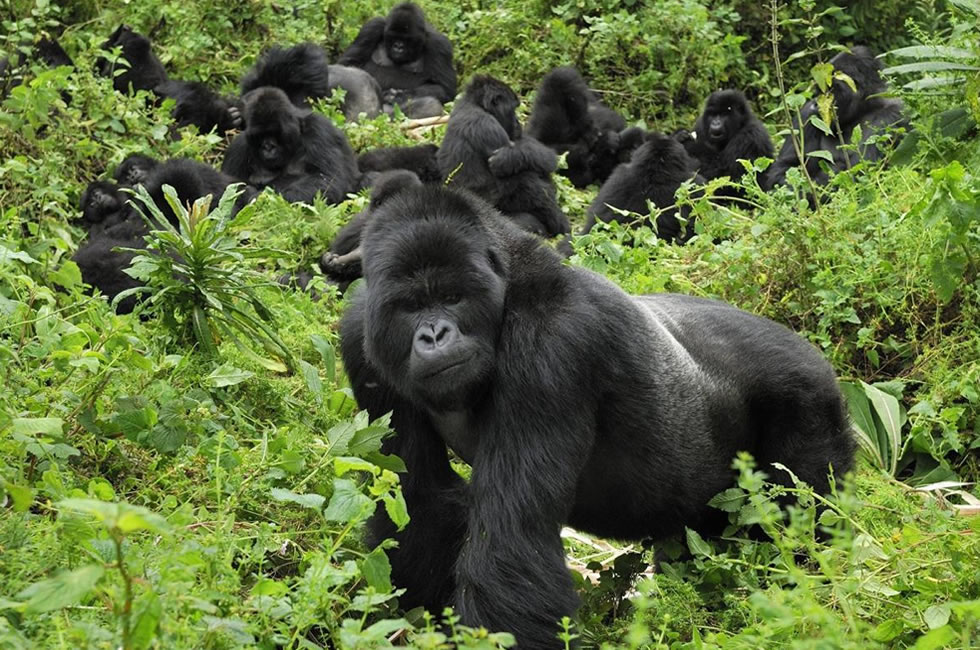Mountain gorillas are the largest apes in the world and they are only found in Uganda, Rwanda and Democratic republic of Congo. The population of mountain gorillas has recently increased from 880 to 1004 individuals according to the 2018 census results. Such increase is attributed to gorilla tourism which is the backbone of long term conservation efforts between the three countries.
However, despite the increase, threats to the survival of gorillas pose a challenge for conservation including loss of natural habitats, poaching, human diseases and conflicts. So it becomes evident that gorilla tourism through gorilla trekking safaris has been responsible for generating revenues to strike a balance between conservation and human needs.
There are 4 national parks where gorillas are protected. They include Bwindi Impenetrable Forest which is home to 480 individuals about half of the world’s gorilla numbers. The other parks are found in the Virunga Conservation Area which spans the borders of Rwanda, Uganda and DR Congo including Volcanoes national park Rwanda, Virunga National Park in DR Congo and Mgahinga National Park in Uganda.
High numbers of tourists visit these places for gorilla trekking safaris and go hiking through the dense forests to see the gorillas in their natural habitat. The gorilla parks are home to a wide variety of flora and fauna including birds, golden monkeys, forest elephants, butterflies.
Along with the gorillas, and other natural attractions, the gorilla parks are surrounded by dense populated indigenous communities of BaTwa, Bakiga and Bafumbira.
The dependence of these communities on natural resources for livelihood posses threats to the survival of gorillas such as habitat loss, human diseases, poaching and civil conflicts.
As tourists pay for the privilege to see mountain gorillas, the revenue earned in dollars is used to pay local rangers to manage and protect the parks and as well as supporting local community development to avert over-dependence on resources.
As much of what ecotourism relates to saving gorillas, eco tourism means responsible travel to natural areas that conserves the environment and sustains the well being of the local people and involves interpretation and education.
Therefore, gorilla tourism revenues are used to conserve and protect gorillas. Without doubt, eco tourism is largely responsible for the thriving number of mountain gorillas in the following ways;
Revenue sharing and community conservation projects
Through revenue sharing scheme, 20 percent of the gorilla trekking proceeds are injected into the adjacent communities to develop schools, hospitals, roads, clean water. Locals are also supported to set up sustainable farms such as vegetable growing, honey bee keeping, and pig and goat rearing which acts as a trade off for bush meat.
The gorilla parks provide employment to the locals such as guides, trackers and rangers. All this set up provides livelihood and has educated locals on the benefits of conserving gorillas rather than poaching and encroaching on the habitats. For example locals are empowered to manage human gorilla conflicts and also collect resources such as wood, medicinal herbs in dedicated zones of the park.
Law Enforcement, Security and trans-boundary collaboration
Political instability is one of the major threats to the survival of gorillas but let’s see how eco tourism has helped.
Gorilla parks are gazetted and protected by armed rangers which clearly help to protect gorillas and their habitats from illegal activities. Rangers also ensure security of tourists and monitoring the movement of gorillas using the ranger based monitoring system in the case where gorilla parks overlap borders. This has helped gorilla numbers to increase especially Virunga conservation has seen increase of gorillas from 480 to 604 according to 2018 gorilla census.
However, some years ago Congo experienced some political instability which led to killing of gorillas. And decline in tourist numbers visiting Virunga national park for gorilla trekking meant there loss of revenues to pay for Virunga park management. That is why there’s need for strong trans-boundary collaboration and security through creation of one strong force of Virunga rangers and organizations such as Virunga alliance, International Gorilla Conservation Program, Great Apes Survival Partnership do a lot of work to protect gorillas which would rather be difficult for a single country like DR Congo to manage. With the return of political stability in DR Congo, we see that once again Virunga national park is safe for gorilla trekking safaris and it does not only saving gorillas but also the lives of rangers.
In Rwanda, the gorilla naming ceremony dubbed Kwita Izina was initiated in 2005 to help raise awareness about conservation of gorillas both locally and internationally. Indeed, it has paid off in a way to keep records of newly born gorillas.
Mountain Gorilla Veterinary doctors
Due to increased tourist visits, there’s a high risk of human infectious disease transmission to gorillas. Gorilla doctors are therefore responsible for intervention to treat sick or injured gorillas.
Gorilla trekking rules and regulations
A set of 8 rules and regulations were developed to limit tourist interaction with gorillas. Some of the rules include maintaining a distance of 7 meters when observing and photographing gorillas and spending 1 hour with gorillas. Among other rules include, only 8 tourists can visit 1 gorilla family per day. This ensures that gorillas are not overwhelmed by tourists and secondary, the gorilla habitats are kept safe since few tourists are allowed to visit the gorillas.
Increase of gorilla permit fees in Rwanda
Rwanda increased its gorilla permit fees from $750 to $1500 per person for seeing gorillas for 1 hour. Prior to the increase, there was tourist congestion leading to degradation of gorilla habitats in volcanoes national park. This strategy helps to limit people who can afford to track gorillas. thus it paves way for healthy habitats and population of gorillas.

Leave a Reply